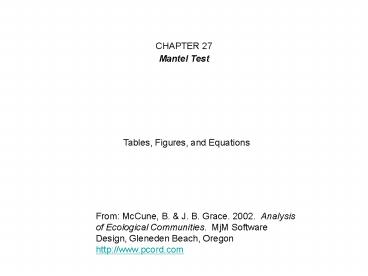Mantel Test - PowerPoint PPT Presentation
1 / 14
Title:
Mantel Test
Description:
The basic question is, 'How often does a randomization of one matrix result in a ... For clarity, the contents of the matrix have been replaced with two digits ... – PowerPoint PPT presentation
Number of Views:378
Avg rating:3.0/5.0
Title: Mantel Test
1
CHAPTER 27 Mantel Test
Tables, Figures, and Equations
From McCune, B. J. B. Grace. 2002. Analysis
of Ecological Communities. MjM Software Design,
Gleneden Beach, Oregon http//www.pcord.com
2
How it works
Mantel test evaluates correlation between
distance (or similarity or correlation or
dissimilarity) matrices. The basic question is,
How often does a randomization of one matrix
result in a correlation as strong or stronger
than the observed correlation? Shuffle the
order of the rows and columns of one of the two
matrices (it doesn't matter which matrix).
3
Schematic showing the simultaneous permutation of
rows and columns
4
The starting matrix for the second of two
symmetrical matrices is shown below. In this
example, each matrix has four sample units. Only
one matrix is permuted. For clarity, the
contents of the matrix have been replaced with
two digits indicating the original row and column
in the matrix. For example, 23 originated in
row 2, column 3.
5
Z is simply the sum of the product of
corresponding non-redundant elements of the two
matrices, excluding the diagonal.
6
Z is simply the sum of the product of
corresponding non-redundant elements of the two
matrices, excluding the diagonal.
The standardized Mantel statistic (r) is
calculated as the usual Pearson correlation
coefficient between the two matrices. This is Z
standardized by the variances in the two matrices.
7
If n is the number of randomized runs with Z ?
Zobs 28.3756, and N is the number of randomized
runs, then
As in this example, the smallest possible p-value
is always 1/(1 N).
8
Example Output (from PC-ORD, McCune Mefford
1999) With Mantels asymptotic approximation the
results are DATA MATRICES Main matrix 19
STANDS (rows) 50 SPECIES (columns) Distance
matrix calculated from main matrix. Distance
measure SORENSEN Second matrix 19
STANDS (rows) 6 ENVIRON (columns) Distance
matrix calculated from second matrix. Distance
measure EUCLIDEAN TEST STATISTIC
t-distribution with infinite degrees of
freedom using asymptotic approximation of Mantel
(1967). If t lt 0, then negative association is
indicated. If t gt 0, then positive association is
indicated. STANDARDIZED MANTEL STATISTIC
.481371 r OBSERVED Z .2838E02
EXPECTED Z .2645E02 VARIANCE
OF Z .1222E00 STANDARD ERROR OF Z
.3496E00 t 5.4969
p .00000005
9
With the randomization method, the form of the
results is somewhat different MANTEL TEST
RESULTS Randomization (Monte Carlo test) method
.481371 r Standardized Mantel
statistic .283756E02 Observed Z (sum of cross
products) .264450E02 Average Z from
randomized runs .120814E00 Variance of Z from
randomized runs .255765E02 Minimum Z from
randomized runs .278301E02 Maximum Z from
randomized runs 1000
Number of randomized runs 0
Number of randomized runs with Z gt observed Z
.001000 p (type I error) ----------------
-------------------------------------------- p
proportion of randomized runs with Z ? observed
Z i.e., p (1 number of runs gt observed)/(1
number of randomized runs) Positive association
between matrices is indicated by observed Z
greater than average Z from randomized runs.
10
Figure 27.1. Scatterplot of dissimilarity of
plots based on grasses against dissimilarity of
plots based on other species.
11
Example output, comparison of two species
groups Method chosen is a randomization (Monte
Carlo) test. Monte Carlo test null
hypothesis is no relationship between matrices
No. of randomized runs 1000 Random
number seeds 1217 MANTEL TEST RESULTS
'Randomization (Monte Carlo test)
method -------------------------------------------
----------------- 0.238500 r Standardized
Mantel statistic 0.158331E03 Observed Z
(sum of cross products) 0.155539E03 Average
Z from randomized runs 0.171850E01 Variance
of Z from randomized runs 0.152315E03
Minimum Z from randomized runs 0.160216E03
Maximum Z from randomized runs 1000
Number of randomized runs 31
Number of runs with Z gt observed Z
0 Number of runs with Z observed Z
969 Number of runs with Z lt observed Z
0.032000 p (type I error) ----------------------
--------------------------------------
12
Figure 27.2. Frequency distribution of Z, the
Mantel test statistic, based on 1000
randomizations for the same example as in Figure
27.1.
13
Table 27.1. Design matrix for Mantel test of
same hypothesis as MRPP no multivariate
difference among three groups. Within-group
comparisons are assigned a zero, between group
comparisons a one.
14
Figure 27.3. Scatterplot of Sørensen distances
in species space against values in the design
matrix (0 within group, 1 between group).
The 0/1 values in the design matrix have been
jittered by adding a small random number.































